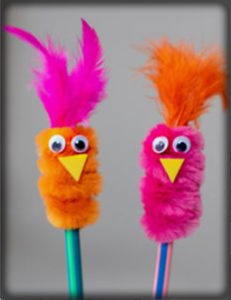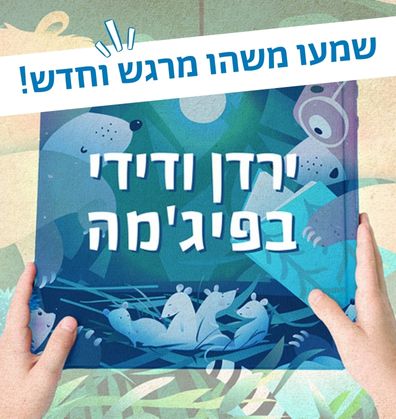טֶבַע וּסְבִיבָה
חורף וגשם
השמיים משנים צבעים... שלוליות, גשם, חלזונות, מטריות ומעילים - החורף הגיע!
בעזרת הספרים בנושא חורף תוכלו לחגוג את חילופי העונות, לשמוח עם הגשם הראשון ולשים לב לטבע ולסביבה המשתנים בחורף.
סְּפָרִים
Book-Related Family Activities

Childhood memories
The grandfather’s friends tell his grandchild about the boy his grandfather once was. Take a moment to share with your child too about the childr you once were, what you liked to do, what you miss, and share childhood photographs. You can also ask your child: What would you tell about yourselves when you were younger? What memories are particularly joyful or moving?
A song from the land of childhood
This book can inspire you to introduce your child to songs that remind you of your childhood or the place where you grew up. You can listen to old songs together and ask: Do you also have songs that remind you of things?
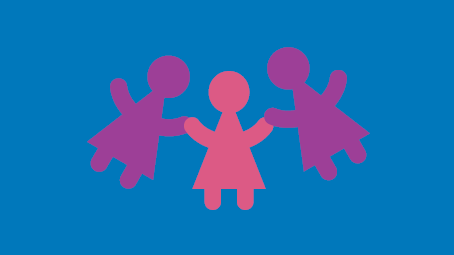
“Buenos Dias”
When the grandfather and father in this book speak to one another in Ladino, the child feels as if they are sailing away together to a faraway land. It is very exciting to understand, know, and utter words in a foreign language. Throughout the book, words and phrases appear in Ladino; you can go back and look for them in the book, then try to pronounce them together, and look .up their meaning

QR code
Scan the QR code and listen to the book Trees Waiting for Rain on the Sifriyat Pijama podcast. We recommend following along with the book while listening.

Family reading advice – Recurring phrases
Many books written for toddlers have a recurring phrase that helps their target audience follow the story and join in the reading. The recurring phrase can be emphasized while reading using a special voice, body movement, or a change of reading pace. For example, when you read bo itanu (“come with us”), you can add an inviting hand gesture, or make the end of the phrase longer – veyesh etzlenu m-a-k-o-m (“and we have r-o-o-m”).

Hosting friends
The girl in this book invites the children to join her under her umbrella and “hosts” them. You can ask the children whether they like to host at home, and who they would like to host.
Sometimes toddlers find it hard to share their games when they host others at their homes. You can discuss that and explain that, just as the umbrella in the book is still the girl’s umbrella, even when she allows others to take cover under it, so do their personal belongings remain theirs when sharing.

Listen to the Song
You can listen to the song as sung on Kan Kids’ children’s show Parpar Nechmad, and join in the singing as well as the dance movements.
Lyrics and music: Datia Ben Dor
Performing Artists: Ester Rada, Uri Banai, Meital Raz, Ami Weinberg.

A family with an umbrella
How many family members can fit under a single umbrella? And how many can fit under a blanket? Or the dining-room table? This book can inspire you to find out how well you can all squeeze into various places in amusing and fun ways.

A walk in the rain
On a rainy day, you can pull on some boots, put on a coat, take an umbrella and go out for a walk in the rain! You can step into puddles and observe the special things that change around us when it’s raining – How many people are outside now? What do the skies look like? What happens when the rain falls on soil or the sidewalk? What kind of smell is in the air?
A piece of advice when reading to toddlers
We recommend reading the book alone first, before reading it as a family. Prior familiarity with the book helps to read it seamlessly later, at a pace suitable for toddlers. Enjoy reading this book!
A discussion on who can help
We can all help others, even toddlers. You may want to ask your toddlers how they can help others, or tell them that they are helping when it happens: “Remember when you helped me set the table?” “Look at you helping me put away the toys!”
Listening to the story
Would you like to listen to the book Noni and his Mom Walk Homefrom Kindergarten? Please scan the QR code to find a recording of this book. You could listen to it while traveling, playing, or sitting together while turning the pages of the book.
A story in illustrations
The illustrations are part of the story, and using them, toddlers identify and recognize the plot and some of its details. You may enjoy looking at the illustrations together, and searching for the items that Nomi gives his mother: ‘Where do you see an illustration of a bag?’ and ‘Where can you find an illustration of a coat?’
Playing a game of ‘An items tower’
Inspired by the items piling on top of mom in this book, you may want to take turns building a tower out of various items: Very carefully, one on top of the other, you can place building blocks, toys, hats, bags, and anything else you might want to add.
A discussion on reeds and cedars
You may enjoy discussing flexibility and stability in life. You may want to share examples from everyday life. Situations in which we behave like cedars, rooted in our positions, or situations in which we are agile, changing our behavior or opinion. What happens when we realize that our desires cannot be met as we expected them to be?
An exercise in physical flexibility
You may enjoy sitting opposite one another, inhaling and lifting your arms up at your sides until they are straight up. Next, exhale while lowering your arms until they reach out in front of you. We recommend doing some short exercises each time and gradually add more. Enjoy!
A game of reed-cedar
What’s the opposite of reed? Cedar! And what’s the opposite of hot? Cold! And the opposite of old? Young! What’s the oppostive of…flexible? stable? sour? baby? Take turns saying a word and having the other players come up with its antonym. By the way, what’s the opposite of… opposite?
Proposed Family Activities:
- Pepper’s nose is blocked and he has a terrible cold (or as the Hebrew original puts it “betsudad dora”). Can you understand what he says? Try blocking your nose and reading Pepper’s dialog. You could also ask your child to translate “cold” into Hebrew, and invent new “cold” words.
- The story is long and suspenseful. You may want to pause at the point where Joezer announces “We’re in trouble”, let your child guess the rest of the plot, and resume reading another day.
- You could ask your child who, in their opinion, had invented the story – Jo or Pepper? You may also enjoy making up your own story, and taking turns to do so. Start the first sentence, then ask your child to add one of their own. Keep going, taking turns, until an entire story comes together. You could even write it up, and draw some illustrations to go along with it.
- Pepper (as well as Marheshvan) is a funny name for a bunny! Does your child know that the month of Heshvan is also called Mar-Heshvan? Mar is Aramaic for drop, and during the month of Heshvan we expect rainfall. Some say the word Mar was added to the name of this month because it is the only one in which we do not mark a single Jewish holiday or fast day. Can your child name all the Hebrew months of the year? You may want to check the Hebrew birthdays of all your family members, and create a Hebrew birthday calendar for the entire family.
- Are any of your child’s classmates unwell? Perhaps someone around you is feeling a little sick? You could think of ways of making them feel better together, like making them a hand-drawn greeting card, calling them, taking over something yummy, or properly visiting them, story and all!
Proposed Family Activities:
- Unlike a story, poem collections may be read in any order we choose. Which poems do you and your child like best? You could read them over and over again, look at the illustrations together, and ask your child to pick a different poem each time.
- You may want to discuss being wet with your child: do they like to get wet? Can we manage without water? How does our family help save water?
- You may enjoy going on a puddle-and-squirting walk. Don’t forget your boots and umbrellas! When you are dry again, return to this book and read some more wet poems.
- Sometimes the rain keeps us from going outside. You may want to prepare a game box for rainy days. Ask your child to decorate an empty shoebox, and fill it up with little surprises: stickers, crayons, bubble-making tubes, and illustrated notes with ideas for family activities on rainy days (word games, book reading, baking etc.). Hide the box, and only open it when it rains!
- Has the first rain fallen yet? What will our rainfall be this year? Your child can be wait for the rain and monitor it by making a rainfall calendar with you. Every evening in winter, draw the appropriate drawing if it had rained that day. At the end of the season, you could count how many days of rainfall there were.
- Do you know any other story or poem about the rain (such as Mira Meir’s Shluli, Magafayim by Miriam Roth, or Ruth Kalderon’s adaptation of Sippur al Geshem)? You may want to look for them at home or at the library, curl up together in a warm (and dry) spot, and read them.
Tickling our imagination
Imagine how Iddo must have felt when the ladybird tickled his hand, and how the little ladybird felt. You may want to ask your child to hold their hand out like a small bowl, and tickle it. You can pretend the ladybird is strolling across their belly, and pleasantly tickle one another.
Hiding out from the rain
The ladybird found shelter in Iddo’s hand. You may want to discuss ways of hiding out from the rain with your child. You could search for umbrellas at home, woolly hats, or any other object used to protect us from the rain. You could also step outside and point to buildings, bus stations, and stores on your way to kindergarten. Can they, too, provide some shelter from the rain?
What did the ant say?
You may want to look at the illustrations together and look through the book for the ladybird’s encounters with each of the other animals: the ants, spider, and cat. Perhaps you could ask your child to tell the story in their own words, and discuss the difference between Iddo’s reaction, and the other animals’ responses.
What do ladybirds do?
Perhaps you would enjoy stepping out to the park or playground, and look for ladybirds (ladybugs). Will you find one among the leaves, or in the sandbox, just like Iddo did in the book? You could place it gently on your hand. Does it tickle? Does it rest, or immediately spread its wings and fly off? It is of course very important to return the ladybirds to nature.
חיפושיות Little stone ladybirdsמאבנים קטנות
You may enjoy collecting smooth, round stones of various sizes, painting them red, and, once the paint dries, marking a black line across them from top to bottom, and adding white spots. And there you have it – a ladybird family!
What pictures tell us:
Your child may want to look at the illustrations, and discover details that do not appear in the text. Were they able to find the cat and bird? What do the animals do on each page?
What do we wear in winter?
You could go to your closet, and look for winter clothes – flannel undershirts, gloves, socks, boots, and umbrellas. You may enjoy playing a game together in which one of you closes their eyes, names an item of clothing, and counts to ten, and the other must put on that item of clothing before the time is up. How well did each of you do?
Young weather forecasters
Children can follow the weather from a young age. Before leaving the house, you may want to ask them to look up at the sky, and report – is it sunny or cloudy? Should we wear a coat, or take an umbrella?
Getting our toys dressed for winter
Does your child’s teddy-bear or doll have a coat, hat, or scarf? You may want to look for pieces of fabric, or used baby clothes, and help your toys prepare for a rain-filled winter too.
Drawing winter on the windows
On cold and rainy days, you could draw on the cold vapor that covers your windows. Perhaps you would like to draw clouds, and ask your child to mark the raindrops with their fingertips. You could add a puddle, or even an umbrella. You may want to return to the window an hour later – what happened to the drawing?
Games for rainy days
You may want to take a shoebox and fill it with various small surprises, such as stickers, special crayons, small containers of soap bubble liquid, and so on. Hide the box, and only open it on rainy days!
Do you like the rain and cold?
You can take a walk outside on wintry days too! You may want to look up at the clouds, and discover what they look like. Can you see a person’s face, or an animal? Perhaps you’ll get lucky, and have raindrops fall on your head. You could also talk as you walk, and tell each other what you like most about winter, and what you do not. What does the air smell like? What do the trees look like? Perhaps you would enjoy picking up dry leaves, jumping into puddles, and feeling the wind blow.
Family Activities:
- Do the members of your family enjoy it when it rains? After reading the story, you might have a conversation with your children and ask them whether they, like Tzafrir, love rain. Why? Who needs rain, and who enjoys it? Ask your children whether they know any other stories, songs, and tales about the rain. You can all snuggle together in a cozy corner of your home and tell stories about the rain.
- Tzafrir asks: “Mommy! Will the rain ever come?” Like many children, Tzafrir is full of anticipation and has a hard time waiting for the rainy season to begin. Suggest to your children that they look for changes in the weather that indicate winter’s coming (for example: birds migrating south, days getting shorter, skies becoming cloudy). You could also have a conversation about things in life that we can control, versus things over which we have no control.
- “Tzafrir was still a little boy last winter”: You might talk about things your children are able to do now that they couldn’t do last winter. You could also take out their shoes, clothes, and boots from last winter and see if they still fit, so your children can see how much they’ve grown and developed since then.
- Your children can join in anticipating and tracking the rain (or snow, if you live in a cold climate). Work together on designing a tracking chart. Every evening during the winter months, they can make a mark (or draw a picture) to indicate whether rain (or snow) fell that day. When the season is over, you can all count together the number of days on which there was some precipitation.
- You can also make a rain collector: take a plastic bottle and cut off the top (be careful not to cut yourselves on any sharp edges!). Place the empty bottle in an open area outdoors, or attach a loop of metal wire and hang it outside your window. How long does the bottle take to fill up? Your children can track the rise of the water level in the bottle, and then decide how they want to use the water they’ve collected.
- You and your children can also go on a puddle expedition, just like Tzafrir and his family. Don’t forget to wear boots and bring an umbrella!
- You can set aside special games and other entertainment, to be opened on rainy days! Ask your children to decorate an empty shoe box. You can then fill the box with small surprises, like stickers, paints, beads, or a bottle of soap bubbles, along with little handdrawn notes containing ideas for fun family activities for a rainy day (play word games; read books; cook and bake; etc.). Hide the box, and bring it out only when it rains!
A discussion on imagining together
Children love to play “make believe”. They enjoy pretending that they are grown up: “Driving” a car, making mud “cakes”, or playing with an imaginary friend. You can play this game with your child using a prop, such as a doll, pot, or toy car, and ask: Where are we going? What are we cooking together? What is the doll saying?
A Game of “Almost the Same”
Ron sees Shluli in the puddle, but, in fact, it is his own reflection in the water. You could also play a game of “mirror” in which two players face one another and take turns pulling a face, moving their head or leg, and having the other imitate them.
Family Activities
You may want to re-read the beginning of the story together, and be reminded of the advantages of being a small cloud. Perhaps later you would enjoy discussing your child’s size with them, and mention things that only little children can do.
Despite the advantages of being small, and her friends’ positive attitude towards her, Cloudette wants more. You may want to discuss wishes and desires: is there anything your child wants to do but has yet to try? Is there anything they would like to do but are unable to due to their age or size? You could make a list of desires together. Perhaps some of them can already be fulfilled!
When Cloudette hears “Ribbit” and sees the dry puddle, she realizes what she can do. You could ask your child whether we always know how to help others, and share stories of help given to another, or how others have helped you exactly at the right time using just the right kind of help.
You may like to notice the bigger clouds’ nicknames for Cloudette, and how they treat her. They do not tease her, but instead accept her the way she is and like her. Following the story, you may want to discuss nicknames with your child, the various relationships between those older and younger, and the desire to be “a big kid”.
Do you like the rain? Following the story, you may want to ask your child whether they like the rain and why, who needs rain, and who enjoys it. Do you know other stories, songs and tales about the rain? You may enjoy curling up together in a warm corner of the house and telling rain stories.
Perhaps you would like to create a rainwater receptacle together. Remove the top part of a plastic bottle by cutting across it (watch out for sharp edges!), place the empty bottle in an open space near your home, or hang it on a wire outside your window. How long did it take it to fill up with rain? Your child may enjoy monitoring the level of water in the bottle, and deciding how to use the rainwater collected.
Family Activity
- Bear’s friends try to cheer him up and make him happy. Each one of them does their best. But how do they do it? Pick one animal and focus on its actions throughout the book. What kind of help does this animal give Bear?
- Have you ever visited a sick friend or relative? Did anyone ever visit you when you were not feeling well? How can we cheer up our kindergarten friends when they are sick?
- The badger gives Bear a herbal tea to drink, made from the medicinal herbs picked by Bear’s friends. You can also make a delicious, warm, herbal tea for your family: Put some herbs like mint (nana), rosemary, lemon verbena, or sage in a teapot. Add four cups of hot water and some honey. Pour a cup of tea for every family member and decorate it with a lemon slice.
- Play “make believe sick”: practice the mitzvah of visiting the sick with your family. Let your child take care of you and help you relax. Tell them what helps you when you’re not feeling well. This is a golden opportunity to remind your children that they have the power to heal others!
- At the end of the story, Bear gets better, and finds out that the friends who helped him recover are all sick! How does Bear “know” to take care of his friends, and how does he manage to take care of so many friends at once? Using stuffed animals or dolls, make a small play showing how Bear takes care of his friends.
“You must exercise great caution concerning your lives” Venishmartem meod lenafshotechem
Sickness is a part of life. We get better thanks to the treatment we receive, as well as thanks to our body, which manages to overcome the illness. In the book of Deuteronomy (Devarim), chapter 4 verse 15, it is written: “You must exercise great caution concerning your lives” (venishmartem meod lenafshotechem). This means that we have the responsibility to take care of our body and maintain a healthy lifestyle.
- How do you take care of your body? Discuss: How do you keep the body clean? What kind of food is healthy? How can we use our body to make it stronger? How do we rest to regain energy?
- Bear’s illness is contagious. Try to think how we can be careful to avoid getting infected (for example: washing our hands, not coming to kindergarten when we are sick). What more can we do?
looking at the illustrations together
You may enjoy looking at the illustrations together and asking your child to tell the story in their own words. How do the various animals respond to the rain? How has the illustrator chosen to depict the rain and wind? We don’t know what Rabbi Hanina Ben Dossa looked like, but we can imagine how he lived his life in those days, and what the Galilean landscape was like. Try to look for signs of the place and time in the various pictures.
dress up as the different characters and act out
You may want to dress up as the different characters and act out the story to your friends and family. Using facial expressions and hand gestures, you could imagine how grateful the birds and animals were for the rain, and how sorry they were when it stopped.
discuss the things that did not exist
Following the story, perhaps you would like to discuss the things that did not exist during the time of the Talmud, and make our winters easier, such as umbrellas, electric heating, and so on.
Do you like the rain
Do you like the rain and look forward to it? Perhaps you would like to discuss fun things to do in winter, and how the rain affects the flora and fauna. Have you ever had to cancel a planned trip or outdoor activity because of the weather? You may want to remind each other of such incidents.
"The whole world is at ease but Hanina is in distress?"
“The whole world is at ease but Hanina is in distress?”: What makes us happy does not necessarily make others happy. You may want to discuss clashing desires within the family, and the ways to cope with them.
ideas for rainy day playtime and entertainment
Perhaps you would enjoy making a box of ideas for rainy day playtime and entertainment. Ask your child to decorate an empty shoebox. In it you can keep little surprises such as stickers, crayons, marbles, soap bubble dispensers, and colorful notes with ideas for family activities on rainy days (word puzzles, reading, cooking and baking, and so on). Stow the box away, and only open it when it rains outside!
Who was Rabbi Hanina Ben Dossa?
Rabbi Hanina Ben Dossa was a Tanna – a Mishnaic sage – who lived in the Galilee some 2000 years ago. He was a wonderful man, and many tales describe his special qualities. Ruth Calderon, the author, based this story of Rabbi Hanina and the rain on the following short excerpt found on page 24b of the tractate of Taanit in the Babylonian Talmud:
חנינא בן דוסא הוה קא אזיל באורחא
Rabbi Hanina Ben Dossa was journeying on the road
אתא מיטרא
it began to rain
אמר לפניו: רבונו של עולם, כל העולם כולו בנחת וחנינא בצער?
He exclaimed: Master of the Universe, the whole world is at ease, but Hanina is in distress?
פסק מיטרא
the rain ceased
כי מטא לביתיה
When he reached home
אמר לפניו: רבונו של עולם! כל העולם בצער וחנינא בנחת?
he exclaimed: Master of the Universe, the whole world is in distress and Hanina is at ease?
אתא מיטרא
It began to rain

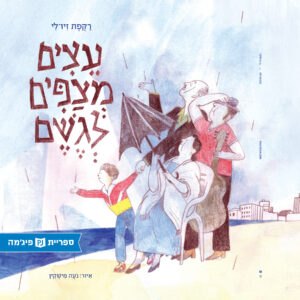 Trees Wait for Rain
Trees Wait for Rain 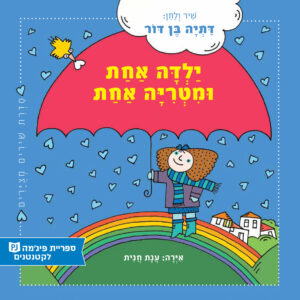 A Girl with an Umbrella
A Girl with an Umbrella 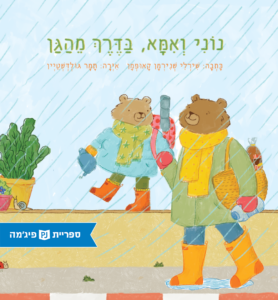 Noni and his Mom Walk Home from Kindergarten
Noni and his Mom Walk Home from Kindergarten 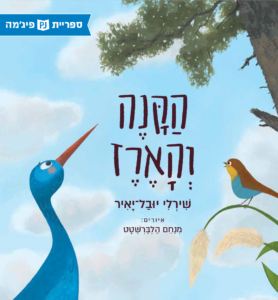 The Reed and the Cedar
The Reed and the Cedar 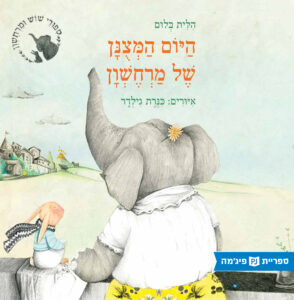 Jo and Pepper and the Big Sleep
Jo and Pepper and the Big Sleep 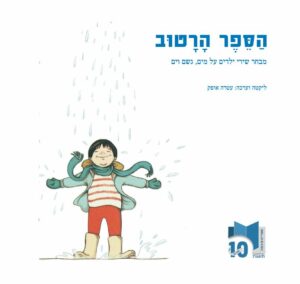 The Wet Book
The Wet Book 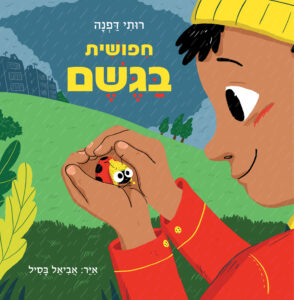 The Ladybird in the Rain
The Ladybird in the Rain 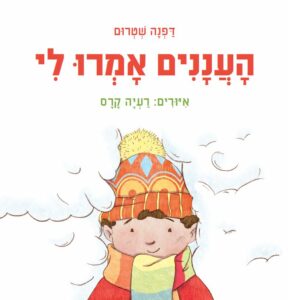 The Clouds Told Me
The Clouds Told Me 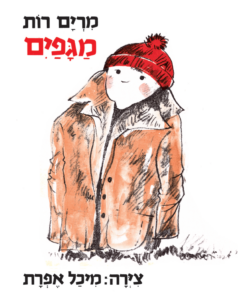 Boots
Boots 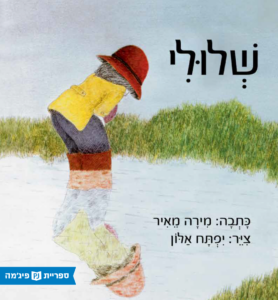 Sheluli
Sheluli 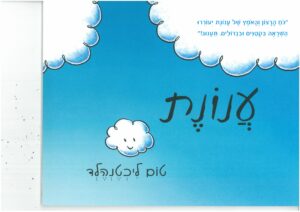 Cloudette
Cloudette 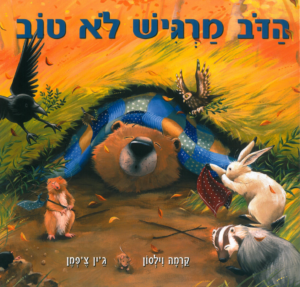 Bear Feels Sick
Bear Feels Sick 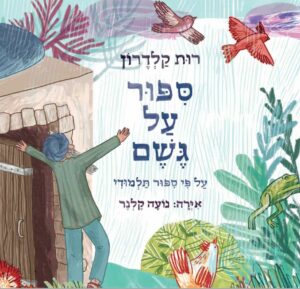 A Story about Rain
A Story about Rain 

